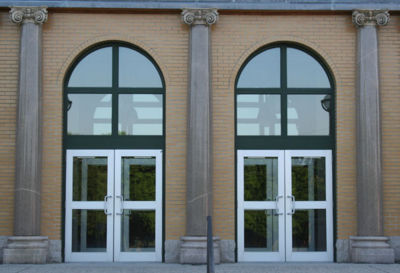Rhode Island College: Difference between revisions
imported>ZachPruckowski m (fix link) |
imported>Subpagination Bot m (Add {{subpages}} and remove any categories (details)) |
||
| Line 1: | Line 1: | ||
{{subpages}} | |||
'''Rhode Island College''' is a state-supported comprehensive college founded in [[1854]], located in [[Providence]], [[Rhode Island]], [[USAUnited States of America|USAUnited States of America]]. Rhode Island College is the oldest of the three public institutions of higher education that operate under the aegis of the Board of Governors for Higher Education. The board consists of 13 individuals appointed by the governor. | '''Rhode Island College''' is a state-supported comprehensive college founded in [[1854]], located in [[Providence]], [[Rhode Island]], [[USAUnited States of America|USAUnited States of America]]. Rhode Island College is the oldest of the three public institutions of higher education that operate under the aegis of the Board of Governors for Higher Education. The board consists of 13 individuals appointed by the governor. | ||
| Line 23: | Line 25: | ||
*[[Viola Davis]], actress | *[[Viola Davis]], actress | ||
*[[Ron McLarty]], actor and novelist | *[[Ron McLarty]], actor and novelist | ||
Revision as of 09:08, 14 November 2007
Rhode Island College is a state-supported comprehensive college founded in 1854, located in Providence, Rhode Island, USAUnited States of America. Rhode Island College is the oldest of the three public institutions of higher education that operate under the aegis of the Board of Governors for Higher Education. The board consists of 13 individuals appointed by the governor.
History
Rhode Island College traces its origins to the Rhode Island State Normal School, established by the act of the General Assembly in 1854. Its founding was the result of energetic lobbying by Henry Barnard, the first state agent for education in Rhode Island, and his successor, Elisha A. Potter.
Rhode Island College's ancestor, one of the nation's first teacher schools, grew out of the movement toward tax-supported universal public education of the mid-1800s, spurred by educational missionaries such as Horace Mann. The school attracted young people from working-class backgrounds, who wanted to teach and had no other way of preparing themselves. Not yet thoroughly convinced of the school's value, the Rhode Island General Assembly curtailed its financial support in 1857 and the school was moved to Bristol, where it lingered until 1865 before closing. In 1869, however, a newly appointed state commissioner of education, Thomas W. Bicknell, began a vigorous personal campaign to revive the normal school. His efforts were rewarded in 1871 when the General Assembly unanimously voted a $10,000 appropriation for the school's re-opening in Providence.
Now called the Rhode Island Normal School (RINS), the institution settled into a period of steady growth punctuated by periodic moves to larger quarters. The general favor won by the school after its first difficult years had passed was confirmed in 1898 when it moved into a large building specially constructed for it on Providence's Capital Hill near the State House (the area presently occupied by the Providence Place Mall). In 1928, another new building was constructed nearby for the observation and demonstration school operated by the institution since the 1890s.
At first the Rhode Island Normal School offered admission to both high school graduates and non-graduates, with high school graduates expected to complete their studies in one year. By 1908, however, the program had been lengthened to two and a half years and restricted to high school graduates. In 1920 the normal school became, by act of the General Assembly, the Rhode Island College of Education (RICE), offering a four year program leading to the degree of Bachelor of Education. At this time the normal observation school, which dated back to the 1890s, was renamed the Henry Barnard School. The college's graduate program also originated in the early 1920s and the first master's degrees were conferred in 1924.
For the next three decades the college remained a small, stable teachers' college with a student body of four to six hundred men and women, most of whom went on to teach in the elementary and junior high schools of the state. Early in the 1950s that calm was shattered by intense debate that arose over the college's role in the state system of higher education, and for a time serious doubt was cast on its continued existence. There were plans to merge the institution with Rhode Island's other four year public institution, the University of Rhode Island (URI). After a long study, the Board of Trustees of State Colleges decided to retain the college and strengthen it.
Current Location
In 1958, the college moved to its current 180-acre campus in Providence's Mount Pleasant section. In 1959 the Rhode Island Commission to Study Higher Education, appointed by Gov. Dennis J. Roberts, recommended, and the General Assembly approved, the development of RICE into a general college. Reflecting the broadening of purpose, the institution's name was changed for the final time to Rhode Island College (RIC) in 1960. It is currently comprised of five faculties and schools -- the Faculty of Arts and Sciences, the School of Social Work, the School of Management, the Feinstein School of Education and Human Development, and the School of Nursing. It has roughly 5,000 full-time undergraduate students, 2,300 part-time undergraduates, and 1,600 graduate students. It has 375 full-time faculty members, 85% of whom have a terminal degree in their respective fields.
Notable graduates
- Annie Smith Peck, mountaineer and classical scholar.
- James Langevin, U.S. Congressman for the 2nd Congressional District of Rhode Island
- Viola Davis, actress
- Ron McLarty, actor and novelist


